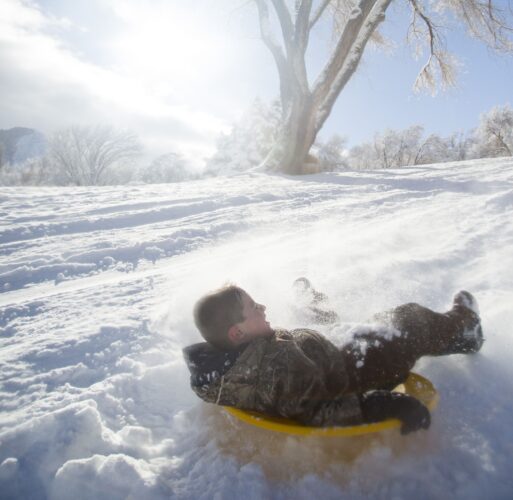Utah health officials talk sledding safety, pass out helmets

BRIANA SCROGGINS, Standard-Examiner file photo
Jaxon Preciado, 7, of Ogden, sleds with his two brothers at the El Monte Golf Course in Ogden on Wednesday, Dec. 23, 2015.Last year, 20-year-old Mckyliee Young of Provo was riding a tube down a snowy hill when it flipped backward and crashed into two metal poles.
The accident was so severe, it fractured her spine and skull, broke 21 ribs, her scapula and collarbone. She ended up at Intermountain Utah Valley Hospital, having brain surgery and most recently hand surgery. But Young said even though she’s had a long road to recovery, she’s grateful her injuries weren’t worse.
“Take sledding seriously,” she said. “It’s not just a kid activity.”
On Saturday, hospital trauma experts from Intermountain American Fork Hospital held a press conference to talk about the dangers of sledding, giving out 48 free helmets, safety information, hot chocolate, bottled water and sunscreen.
“Sledding and skiing is just like driving a vehicle,” said Dr. John Wennergren, trauma director at Intermountain American Fork Hospital. “You want to be aware of the slopes and the surroundings as well as others around you. We see a lot of sledder-versus-sledder accidents at American Fork Hospital.”
Last year, 12,470 people were treated in emergency departments across the country for sledding-related accidents, according to the latest Consumer Product Safety Commission. The most common injuries include sprains, strains, fractures, dislocations and head trauma. Helmets are a vital form of prevention when it comes to head-related accidents.
“Studies have found that increased helmet usage rate has led to a decline in the number of serious head injuries,” Wennergren said. “However, a helmet doesn’t protect your head if it’s not worn and secured.”
Other trauma caregivers from the hospital as well as the members of the Lone Peak Fire Department were on hand to give out tips and other recommendations when sledding and participating in other snow activities such as skiing and snowmobiling, such as:
- Ride forward, and feet first or while sitting up, to help prevent head injuries.
- Separate young children from older children, and one person per sled.
- Wear a ski or snow helmet.
- Ensure the slope is free of obstructions like trees or fences, is covered in snow (not ice), is not too steep and ends with a flat runoff.
- Keep sledders away from motor vehicles.
Symptoms of head or brain injuries include:
- Blurred vision.
- Headache.
- Slurred speech.
- Dizziness.
- Vomiting.
- Temporary loss of consciousness.
- Confusion.
- Swelling.
If you notice any of these symptoms in yourself or someone in your group, get help immediately and don’t refuse medical attention, even if you think you feel fine. Time is critical in this type of situation, the experts warned.
